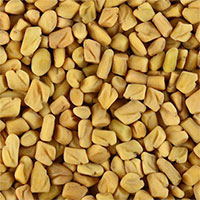
Overview
Trigonella foenum-graecum, also known as Fenugreek, is an annual plant that belongs to Fabaceae family. It is commonly known as Methi.
Occurrence of Trigonella Foenum-Graecum (Methika)
Fenugreek plant is found in Afghanistan, Pakistan, India, Iran, Nepal, Bangladesh, Egypt, Spain, France, Turkey, Morocco and Argentina. India is the largest producer of fenugreek. The major fenugreek producing states in India are Gujarat, Rajasthan, Uttarakhand, Madhya Pradesh, Maharashtra, Haryana, Punjab and Uttar Pradesh. Rajasthan alone accounts for over 80% of production.
Plant Description
The fenugreek plant is an aromatic annual plant that grows up to a height of 60 cm with branched and tapering roots. The leaves of this plant are alternate, lanceolate and trifoliate. The leaflets of this plant are shortly stalked and are oblongated. The flowers are white in color and are present in the axils of the leaves. The fruit pods, when young, are erect and then bend downwards with about 10 to 20 seeds per pod. The seeds of this plant are yellowish brown in color and are hard and angular in shape. Some of the seeds are of rhombic shape.
Cultivation of Trigonella Foenum-Graecum (Methika)
The Fenugreek plant is grown as an annual crop from their seeds. The seeds of this plant are sown using the line sowing method. The land for the sowing should be well prepared. Irrigation channels are made along the alternate rows of bed, for an irrigated crop. Before sowing, the seeds of this plant should be treated with rhizobium culture. After sowing, the seeds germinate within 6-8 days. Depending upon the type of soil, the number of irrigations are required. Usually, minimum two hoeings and weedings are required to keep this crop weed free and well aerated.
Uses of Trigonella Foenum-Graecum (Methika)
Fenugreek is used as dried or fresh leaves, spice (seeds), as well as a vegetable (fresh leaves, sprouts, and micro greens). The sweet smell of the fenugreek is due to the chemical, Stolon. The yellow to amber colored seeds of fenugreek are frequently used in the cuisines of the Indian Subcontinent. They are used as both whole and in the powdered form in the preparation of pickles, pulses, vegetable dishes. They are also used in the spice mixes. They are often roasted to reduce the bitterness and to enhance the flavor as well.
Chemical Constituents Present in Trigonella Foenum-Graecum (Methika)
Fenugreek is the natural source of silicon, iron, sodium and thiamine as well. The seeds of fenugreek contain various alkaloids in it. The major alkaloids are Gentianine, Trigonelline, and Carpine compounds. The fenugreek seeds also contain fibre, fenugreekine and 4-hydroisoleucine.
Ayurvedic Energetics of the Trigonella Foenum-Graecum (Methika) Plant
Ayurveda is an oldest system of healthcare that provides the natural way to take care of the body.
Ayurvedic energetics of this plant are listed below:
- Element: Water
- Guna: Laghu (light), Snighdha (oily)
- Virya: Ushna (hot)
- Taste: Bitter, pungent, sweet
- Vipaka: Pungent
- Energetics: Heating or Pungent
- Doshas: VK-, P+
- Systems: Digestive, respiratory, urinary, reproductive Tissues: Plasma, blood, marrow, and nerve, reproductive
To buy Methika Powder, please visit store.planetayurveda.com/products/methika-powder
